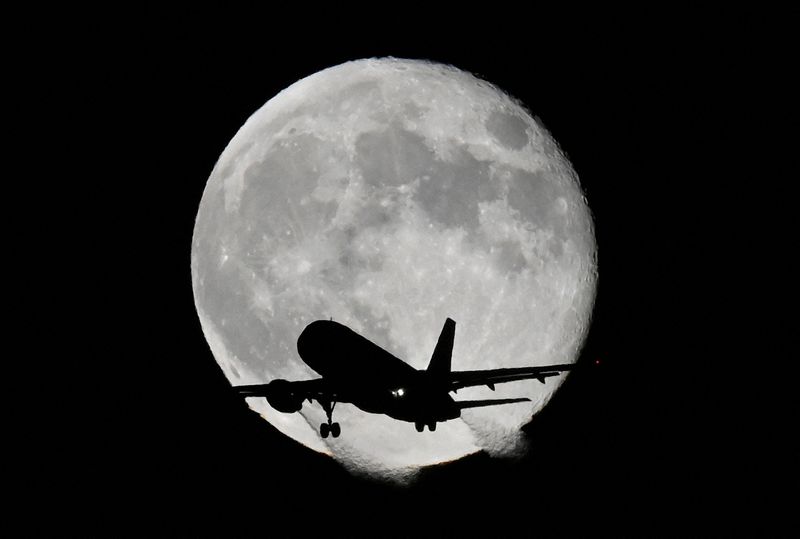By Allison Lampert and Rajesh Kumar Singh
MONTREAL/CHICAGO (Reuters) - The return of North American flights to Asia-Pacific is accelerating heading in to 2024, as carriers bet on the region as the next source of high-margin revenue at a time of soaring costs.
A rebound in Asia is especially important for airlines where long-haul travel makes up a bigger mix of revenue. Carriers tapped pent-up demand last summer with sky-high fares on flights to Europe, but a return of those prices may not be in the cards next year as capacity grows, some analysts said.
Business travel, a cash cow for airlines, is also rebounding in Asia. Travel spending in Asia Pacific is set to grow 41% this year to $567 billion, and rise to $800 billion by 2027, according to data from the Global Business Travel Association.
Air Canada's estimated traffic to Asia would be "closer to 80-something percent" of 2019 levels next year, the carrier's vice president of network planning told Reuters. The planned capacity, which has not been previously reported, is a strong rebound from 2022, when the carrier's Asia-Pacific traffic was 33% of 2019 levels.
While United Airlines, American Airlines (NASDAQ:AAL) and Delta Air Lines (NYSE:DAL) are offering fewer seats to Asia Pacific in the current quarter compared with 2019, the numbers are up 75% on an annual basis, according to aviation analytics company Cirium.
In the first three months of 2024, the numbers will be up about 79% year-on-year. In contrast, seats on the flights of the three U.S. carriers to Europe will grow an annual 6%.
Travel to Asia is also a source of high-margin revenue at a time when soaring labor and fuel costs are pressuring profit and domestic fares are declining.
"The market here in the United States is more mature," United's chief commercial officer, Andrew Nocella, said at a conference earlier this month. "The growth rates of 7% or 8% or 9% for the industry are just not going to be possible, but growing overseas, we think there's just a lot more opportunity."
SUPPLY-DEMAND MISMATCH
Asia-Pacific has lagged behind the U.S. and Europe in global travel demand recovery after the pandemic. While passenger traffic in the region has surged since the reopening of borders, international airline capacity remains below 2019 levels.
The supply-demand mismatch is driving up profit margins for carriers. Asia-Pacific was the second-best market for passenger earnings after transatlantic for both United and Delta in the third quarter.
Delta is shifting capacity to international leisure destinations as domestic flights grow more modestly. The Atlanta-based carrier will increase capacity to Asia-Pacific by as much as 50% in the December quarter and expects the new flying to be "profit-accretive."
Rival United also plans to ramp up capacity in Asia Pacific at the cost of domestic growth, as it bets on flights like U.S. to Manila, Philippines, and San Francisco to New Zealand to deliver the "strongest short-term results."
Overall, Chicago-based United has almost doubled the number of seats on flights to Asia in the current quarter from a year ago, according to Cirium.
Across the border, Air Canada said the increase in Asia Pacific capacity would more than double its overall system growth.
Demand for increasing flights to Asia out of Air Canada's Vancouver hub is expected to come partly from growing Asian immigration to Canada, along with U.S. passengers, Mark Galardo, vice president for network planning, said in an interview.
Canada's largest carrier has a strategy of flying Americans from U.S. cities that connect through its Canadian hubs toward overseas destinations.
About 80% of that traffic now goes to Europe, compared with 20% to Asia, but it would shift as Asian travel grows, Galardo said.
"Our forecast is that ... it would shift within a range of 5 to 10 percentage points," said Galardo, adding it was too early to give a specific number for next year.
However, closed Russian airspace as well as depressed Chinese travel to North America remain hurdles.
The need to avoid Russian airspace due to the war with Ukraine has made it tougher for North American carriers to fly to destinations like Hong Kong from East Coast hubs Newark, New Jersey; and Atlanta and Toronto.
Similarly, Chinese tourists are still not back in full force. In 2019, 2.8 million tourists from China came to the U.S., but research group Tourism Economics expects a mere 991,000 to arrive this year.
Uneven recovery in Chinese travel demand is an unknown for the carriers, but tight supply should help profit, Raymond James analyst Savanthi Syth said.
"I feel like Asia-Pacific is six-to-12 months behind what you've seen on the transatlantic – China being the wild card in all this," she said.
